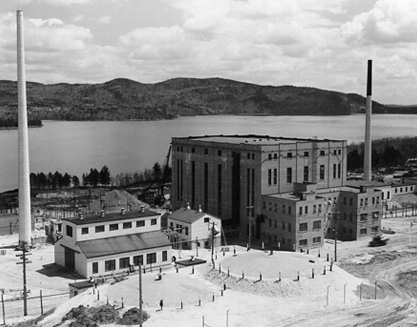|
Tandem Accelerator Superconducting Cyclotron
Tandem Accelerator Superconducting Cyclotron (TASCC) was a Canadian particle accelerator facility constructed at Chalk River Laboratories on October 3, 1986. TASCC was the world's first Tandem Accelerator and able to accelerate most elements to 10 MeV per nucleon. The TASCC facility was decommissioned beginning in 1996. See also * Canadian Penning Trap Mass Spectrometer The Canadian Penning Trap Mass Spectrometer (CPT) is one of the major pieces of experimental equipment that is installed on the ATLAS superconducting heavy-ion linac facility at the Physics Division of the Argonne National Laboratory. It was develo ... References Atomic Energy of Canada Limited Particle physics facilities {{accelerator-stub ... [...More Info...] [...Related Items...] OR: [Wikipedia] [Google] [Baidu] |
Particle Accelerator
A particle accelerator is a machine that uses electromagnetic fields to propel charged particles to very high speeds and energies, and to contain them in well-defined beams. Large accelerators are used for fundamental research in particle physics. The largest accelerator currently active is the Large Hadron Collider (LHC) near Geneva, Switzerland, operated by the CERN. It is a collider accelerator, which can accelerate two beams of protons to an energy of 6.5 TeV and cause them to collide head-on, creating center-of-mass energies of 13 TeV. Other powerful accelerators are, RHIC at Brookhaven National Laboratory in New York and, formerly, the Tevatron at Fermilab, Batavia, Illinois. Accelerators are also used as synchrotron light sources for the study of condensed matter physics. Smaller particle accelerators are used in a wide variety of applications, including particle therapy for oncological purposes, radioisotope production for medical diagnostics, ion ... [...More Info...] [...Related Items...] OR: [Wikipedia] [Google] [Baidu] |
Chalk River Laboratories
Chalk River Laboratories (french: Laboratoires de Chalk River; also known as CRL, Chalk River Labs and formerly Chalk River Nuclear Laboratories, CRNL) is a Canadian nuclear research facility in Deep River, about north-west of Ottawa. CRL is a site of major research and development to support and advance nuclear technology, particularly CANDU reactor technology. CRL has expertise in physics, metallurgy, chemistry, biology, and engineering, and hosts unique research facilities. For example, Bertram Brockhouse, a professor at McMaster University, received the 1994 Nobel Prize in Physics for his pioneering work in neutron spectroscopy while at CRL from 1950 to 1962. Sir John Cockcroft was an early director of CRL and also a Nobel laureate. Until the shutdown of its nuclear reactor in 2018, CRL produced a large share of the world's supply of medical radioisotopes. It is owned by the Canadian Nuclear Laboratories subsidiary of Atomic Energy of Canada Limited and operated under con ... [...More Info...] [...Related Items...] OR: [Wikipedia] [Google] [Baidu] |
Nucleon
In physics and chemistry, a nucleon is either a proton or a neutron, considered in its role as a component of an atomic nucleus. The number of nucleons in a nucleus defines the atom's mass number (nucleon number). Until the 1960s, nucleons were thought to be elementary particles, not made up of smaller parts. Now they are known to be composite particles, made of three quarks bound together by the strong interaction. The interaction between two or more nucleons is called internucleon interaction or nuclear force, which is also ultimately caused by the strong interaction. (Before the discovery of quarks, the term "strong interaction" referred to just internucleon interactions.) Nucleons sit at the boundary where particle physics and nuclear physics overlap. Particle physics, particularly quantum chromodynamics, provides the fundamental equations that describe the properties of quarks and of the strong interaction. These equations describe quantitatively how quarks can bind toget ... [...More Info...] [...Related Items...] OR: [Wikipedia] [Google] [Baidu] |
Canadian Penning Trap Mass Spectrometer
The Canadian Penning Trap Mass Spectrometer (CPT) is one of the major pieces of experimental equipment that is installed on the ATLAS superconducting heavy-ion linac facility at the Physics Division of the Argonne National Laboratory. It was developed and operated by physicist Guy Savard and a collaboration of other scientists at Argonne, the University of Manitoba, McGill University, Texas A&M University and the State University of New York. Development The CPT was originally built for the Tandem Accelerator Superconducting Cyclotron (TASCC) facility at Chalk River Laboratories in Chalk River, Ontario, Canada. However, it was transferred to Argonne National Laboratory when the TASCC accelerator was decommissioned in 1998 due to funding issues. The CPT spectrometer is designed to provide high-precision mass measurements of short-lived isotopes using radio-frequency (RF) fields. Accurate mass measurements of particular isotopes such as selenium-68 are important in the understandi ... [...More Info...] [...Related Items...] OR: [Wikipedia] [Google] [Baidu] |
Atomic Energy Of Canada Limited
Atomic Energy of Canada Limited (AECL) is a Canadian federal Crown corporation and Canada's largest nuclear science and technology laboratory. AECL developed the CANDU reactor technology starting in the 1950s, and in October 2011 licensed this technology to Candu Energy (a wholly owned subsidiary of SNC-Lavalin). Today AECL develops peaceful applications from nuclear technology through expertise in physics, metallurgy, chemistry, biology and engineering. AECL's activities range from research and development, design and engineering to specialized technology development, waste management and decommissioning. AECL partners with Canadian universities, other Canadian government and private-sector R&D agencies (including Candu Energy), various national laboratories outside Canada, and international agencies such as the IAEA. AECL describes its goal as ensuring that "Canadians and the world receive energy, health, environmental and economic benefits from nuclear science and techn ... [...More Info...] [...Related Items...] OR: [Wikipedia] [Google] [Baidu] |

